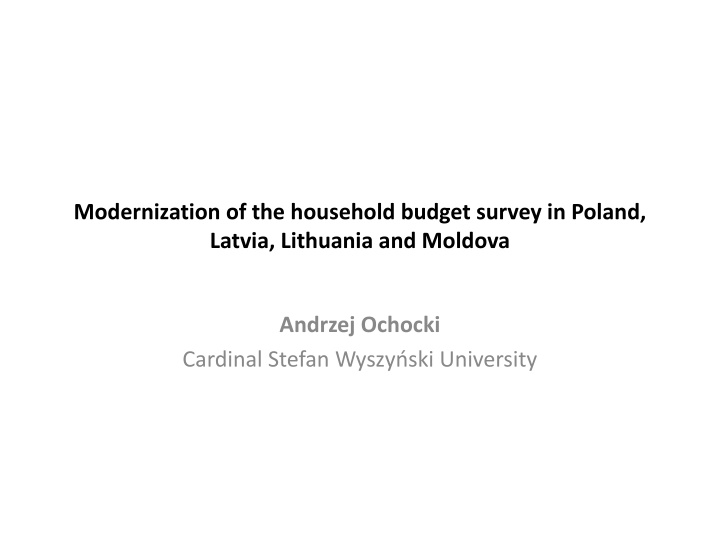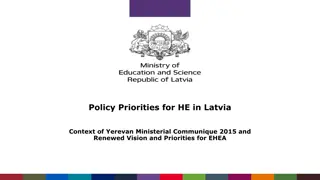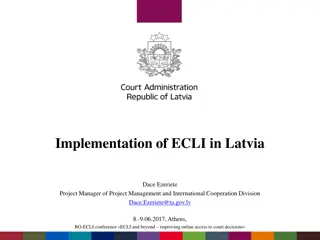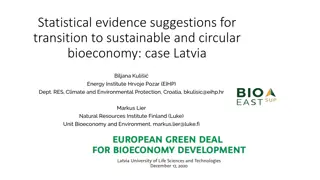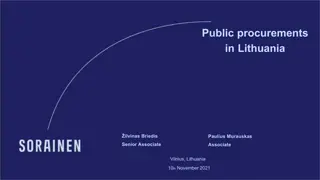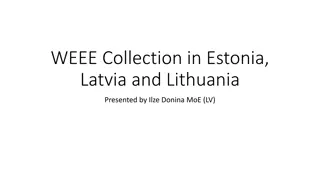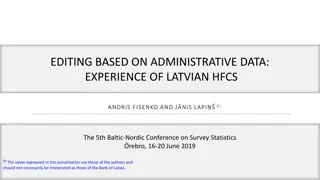Modernization of Household Budget Survey in Poland, Latvia, Lithuania, and Moldova
The project aims to define economic categories, identify new income groups, and develop effective methods for surveying household budgets in partnership with the World Bank. It focuses on the economic basis of household budgets and the macroeconomic calculus of total household income.
Download Presentation

Please find below an Image/Link to download the presentation.
The content on the website is provided AS IS for your information and personal use only. It may not be sold, licensed, or shared on other websites without obtaining consent from the author.If you encounter any issues during the download, it is possible that the publisher has removed the file from their server.
You are allowed to download the files provided on this website for personal or commercial use, subject to the condition that they are used lawfully. All files are the property of their respective owners.
The content on the website is provided AS IS for your information and personal use only. It may not be sold, licensed, or shared on other websites without obtaining consent from the author.
E N D
Presentation Transcript
Modernization of the household budget survey in Poland, Latvia, Lithuania and Moldova Andrzej Ochocki Cardinal Stefan Wyszy ski University
Premises for modernization the need to define the resulting economic categories of the household budget in connection with national accounts in a market economy, the need to identify new income groups of the population based on the main source of household maintenance, the possibility of using more effective methods and research tools.
World Bank Project (1994 1997) Aims and assumptions: the need to obtain information about the living conditions of the population in order to prepare assistance programs for the countries covered by the project (outside Poland), the transfer of know-how to the countries that are in the process of transition to the market economy, training and gaining research experience by statisticians from Poland, Latvia, Lithuania and Moldova, the co-authoring principle that obliges experts from Poland to develop a methodology for examining household budgets together with statisticians of state statistics institutions in Latvia, Lithuania and Moldova (educational component).
Economic basis of the household budget The household - as a market economy entity - generates, on one hand, a supply of labour and capital, and on the other hand, it is a consumer of goods and services purchased mainly for income from employment in the companies and agriculture sector, income from social benefits and income from property, In the process of GDP distribution, the household budget is also a tool for distributing income for consumption and savings.
Macroeconomic calculus of total household income Income generation: 1. D = GDP+ B Td where: D disposable household income, GDP gross domestic product at factor cost, B transfer payments in the state (pensions and disability allowances, family benefits, unemployment benefits, subsidies for medicines, subsidies for communication services, etc.) Td direct taxes, i.e. income tax, pension contributions, health insurance contributions, etc.
Macroeconomic calculus of total household income Income distribution: 2. D = W + O where: D - disposable household income W household expenses O increase in household savings (population)
Microeconomic calculus of disposable income of household Sources of income 3. D = P + S + K where: D disposable household income, P wages of household members and other income from work, S social benefits received by members of the household, such as pensions, benefits, etc. K property income and other types of income.
Microeconomic calculus of disposable household income Disposing of disposable income: 4. D = W + O where: D = disposable income included in the household survey, W = expenses included in the household budget O = increase in household savings
The increase in household savings The increase in savings as a result of the GDP distribution is the same residual category in both accounts, but the monetary amount of household savings determined on the basis of the examination of their budgets is usually much lower for a number of methodological and practical reasons. The main reasons for the differences are: differences in the subject range of the information collected, e.g. considering gifts in hbs causes D '> D, hbs does not take into account all social transfers, for example, subsidies for medicines funded from the state budget causes that S <B.
Income sensitive variable Income in social research is a sensitive variable, e.g. due to the presence of so-called hidden economy , which manifests itself in the tendency to underestimate income in households.
Household income and expenditure The key tools linking the allocation of gross domestic product to the resulting economic categories of the household budget are income and expenditure classifications used in household budget surveys. The involvement of specialists of the Department of Demographic and Social Research of the CSO in methodological work of EUROSTAT, aimed at harmonizing household surveys in European Union countries, enabled parallel work to modernize the methodology for examining household budgets in Poland, Latvia, Lithuania and Moldova.
EUROSTAT recommendations The classification of revenues and expenditures in household budget surveys is linked to the System of National Accounts (SNA) and the European System of Accounts (ESA). In the scope of consumption expenditure, The Classification of Individual Consumption by Purpose for Household Budget Surveys is recommended by EUROSTAT (the extended COICOP / HBS).
Comparising the results of household budget surveys with the results of national accounts (Miko aj Haponiuk, Phd - dissertation) In Poland, after the implementation of new revenues and expense classification, based on the data for 1997, it was established that: the degree of compliance of the main expenditure items for consumer goods and services was high: 95% for food, 90% for clothing, 69% for housing and 72% for health, the value of the total aggregate of consumer goods and services expenditure in household budgets was 67% of the value generated in the household sector of the national accounts, Income from contract work accounted for 73% of the amount obtained in national accounts, and all income available for 58%.
The need to improve methods of household income survey An international group of experts in the field of household income statistics has been performing the analyses of the compatibility of national accounts and household budget surveys in various countries for many years. These analyzes are helpful in improving the methodology of examining household budgets, especially their income. In Poland, a more effective method was applied in the study of income and living conditions of the population in 2011 as part of the European Union Statistics on Income and Living Conditions (EU-SILC). It is advisable to compare the obtained results with the data obtained in national accounts.
The basic scope of analyses of living conditions of the population on the basis of household budgets Diversification of consumer spending between income groups of households, Poverty of the population with the use of relative lines based on the distribution of expenses, The costs of keeping a child in the household using the consumption equivalence scale, Monetary basis for shaping the minimum wage using the distribution of consumption expenditure on goods and services.
